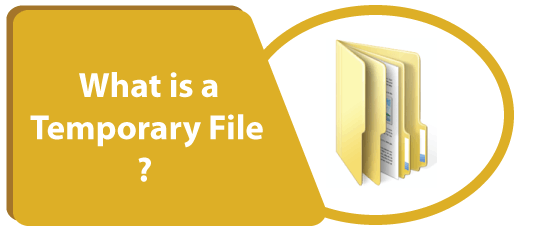What is a Temporary File?
Temporary files are files that are generated to temporarily store data. These files are created by the programs that users use or by Windows itself. These files help the computer work smoothly when users utilize related apps or tasks: they are also known as a foo file or temp file.

When you exit the program, the temporary file is removed. Temporary files are those that contain the temp extension. However, these can vary depending on the program that is in charge of creating them. When you work on the editing program on the computer for text authoring, media, or graphics, temporary files are created for your work in progress. These files are useful not only for making your software operate quicker and smoother; they also aid in the creation of recovery backups of your data if your computer shuts down unexpectedly or automatically.
A temporary file is created for a variety of purposes, such as breaking up huge chunks of data into more manageable parts, or when a program manipulates data larger as a traditional way of executing inter-process communication. In terms of backup, Microsoft’s Office apps are the best example of these files. For instance, Microsoft Word and Excel create a temporary file that indicates the machine has recovered from unexpected shutdowns or crashes when they are associated with the currently active document.
Using Temporary Files on a Computer
Numerous users on the computer employ ISO RAR files; they may have noticed the temporary extraction of files. They immediately remove files from your temporary folder after extracting them; this is done when the operation is complete, and you may then use them for installation or other purposes. When the task is completed, most temporary files are automatically erased; however, some files remain in your storage for future usage.
They reduced the wastage of memory and improved the system performance without harming any of the system components, which is very efficient enough to use.
How to create temporary files?
The name of the temporary file is determined by the program and operating system. For example, Windows programs including Microsoft Windows frequently create files with the .tmp file extension as temporary files. Programs such as Microsoft Word can generate a temporary hidden file, which is denoted by a tilde and a dollar sign. Programs with the .foo file suffix can also produce temporary files under Linux.
Till now, we’ve learned how to create the temporary files. So now we’ll learn how to spot them on our computer.
Looking for .tmp files in your computer
Users of Windows NT, Windows 95, Windows 98, and other related operating system software can use the methods below to search for and delete any .tmp files.
To begin with the search for temporary files:
- Click on the start button to access the menu.
- Then, select the find files or folders option after clicking on the find option.
- Type ‘*.tmp’ in the named box to search for files in the “tmp” file extension that are available on the system.
- You must ensure that the look in the search box area is not displaying document folders and is not linked to the C: disk.
- Then, to begin the search, press the Find Now button. After you have performed all of the above tasks, you must now ensure that the temporary folder is empty by performing the required steps which can explained further.
- Double-click on the My Computer icon on the Windows desktop to access the hard disk. You must now double-click on the C drive.
- Then, access the temp folder by double-clicking on it (if it exists) and ensure that you have erased all possible files in the folder.
- After closing the window, reopen my computer, and open the C drive once again.
- Then, double-click on the temp folder to check that all possible files in this folder have been deleted.
Where do temporary files go?
A temporary file’s location changes based on the program and operating system. There has always been some kind of temporary directory in Microsoft Windows. Early versions of Windows used the C: WindowsTemp directory, whereas newer versions keep the temp directory in the AppData subdirectory.
How to delete temporary files?
You can open temp files by clicking the start button and then typing %tmp% into the search area. To open the temporary files in Windows XP and earlier versions, choose the run option in the start menu and type%temp% in the run field. Then press Enter or click OK to open the temp folder. You can now quickly delete all files detected in this folder, and the files will be skipped if they are in use. Then restart your computer; you should notice an improvement in performance.
Is deleting temporary files safe?
Yes. Temporary files are used to briefly store information and do not rely on the information stored in the file. However, removing an active temporary file may create application issues. Many programs lock the file while it is in use to prevent it from being erased, which helps to prevent difficulties. When a program creates a temporary file, it deletes it after the document or application that was using that temporary file is closed. If all programs have been closed and temporary files remain, they can be safely erased.
If the temporary file is required again after it has been destroyed, it is created when the program is reopened.